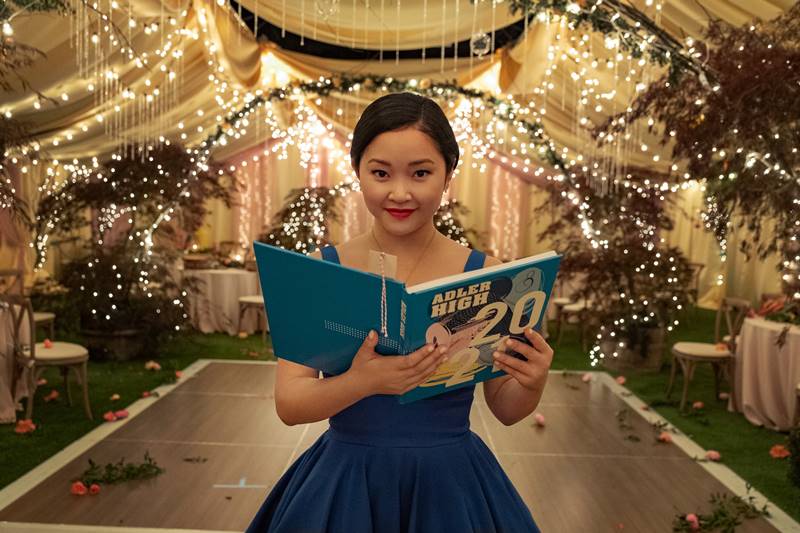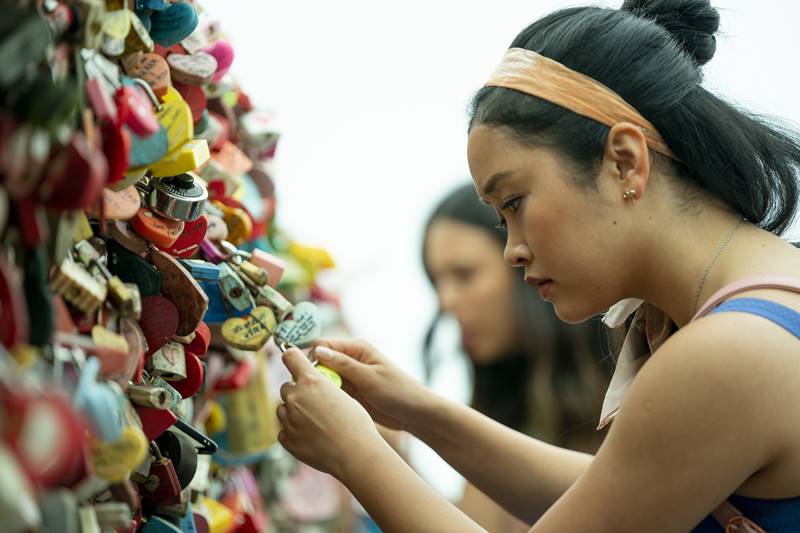By Jae-Ha Kim
Teen Vogue
February 12, 2021
By now, we know that the thrust of the To All the Boys trilogy is the unlikely relationship between studious Lara Jean Covey (Lana Condor) and the high school’s most popular boy, Peter Kavinsky (Noah Centineo). The big reveal at the end of each film is whether or not the pair break up. The difference with the latest film is that since this is the final chapter in the series, it’s not a given that the pair will remain together always and forever, as Lara Jean writes to Peter during her spring break in South Korea.
To All the Boys: Always and Forever kicks off in Seoul, where Lara Jean’s late mother had been born and raised. The entire Covey clan – sisters Margot (Janel Parrish) and Kitty (Anna Cathcart), their father Dan (John Corbett) and his girlfriend Trina (Sarayu Blue) – take this trip together. In between the outings to all the cute cafes, skincare boutiques and outdoor snack shacks, Lara Jean contemplates her Koreanness, or lack thereof. In a late night phone call with Peter, she tells him what it felt like when a Korean girl assumed she must be fluent in the language.
“It’s like they see me and think I understand,” she said. “And then I don’t. I guess I just wish my mom was here to teach me.”
This passage was meant to be heartwarming and set up the inner conflicts Lara Jean faces as she grows older. But I wondered, why would Koreans think she knew the language? The Covey sisters are half white and half Korean. No local would look at Lara Jean and think she was a native who could speak Korean. If anything, they would treat her as a gyopo – an ethnically Korean person who lives in a foreign country.
When the sisters visit a noraebang – which literally translates to a singing room – they choose Iggy Azalea’s “Fancy,” rather than a K-pop song with lyrics that they wouldn’t be able to understand.
Though Always and Forever is delightful to watch – especially for Asian Americans who rarely see themselves represented on screen – it at times feels like a carelessly wrapped gift. Why harp on Lara Jean’s Korean heritage when it’s used almost as a prop? Send the Coveys to Seoul! Have Lara Jean question being half Korean! And then simply drop it from the rest of the movie.
The film’s soundtrack does include a trio of songs by K-pop girl groups, which was a fun way to acknowledge Lara Jean’s two cultures. The film opens with Girls’ Generation’s iconic 2009 hit “Gee.” The optimistic giddiness of the lyrics – about a girl whose heart skips a beat when she thinks about the boy she loves – encapsulates how Lara Jean feels about Peter. BLACKPINK’s diss track “Pretty Savage” plays when Kitty blithely tells Lara Jean she won’t miss her much when she goes away to college. And when Kitty has the meet-cute (with a Korean boy!) that Lara Jean feels she and Peter never had, Cherry Bullet’s bubbly “Q&A” plays: “Hey boy/ … Why am I drawn to you? / Tell me all about you.”

Some of the criticism that the TATB films have received is that none of Lara Jean’s crushes have been Asian boys (except for Edward Kim, who is briefly mentioned but never shown). One could argue that Lara Jean goes to a very white school and has a limited dating pool. But it’s also weird that a film that works so hard at appearing diverse is lacking when it comes to casting an actual Korean in any role of substance. Someone like Joe Seo, who was so superb in the critically acclaimed Spa Night and who plays against type as a bully in Netflix’s Cobra Kai, would’ve been a welcome addition to the cast.
Back home and in Peter’s arms, Lara Jean has to figure out how to tell him that their college plans of attending Stanford University together won’t happen. In a plot twist of the model minority myth, Lara Jean is rejected, while the academically-challenged Peter is accepted on a lacrosse scholarship. When Margot suggests that Lara Jean keep her academic options open and apply to New York University, she bristles at the thought. She comes up with a litany of reasons as to why it’s a bad idea, but it all boils down to one thing: she doesn’t want to be away from Peter.
This scenario is exactly what their mother hadn’t wanted for her daughters. Her wish was the driving force behind Margot breaking up with her high school sweetheart before heading off to college (in the first film). This is the dilemma that Lara Jean frets about for most of Always and Forever. She looks conflicted when her father gently tells her: “You can’t save this relationship by not growing.”
The heart of this movie comes courtesy of the warm chemistry between Lana and Noah, who are so likable together. Viewers are invested in their relationship, because the two make love seem worth fighting for.
Early in the film, the Coveys visit N Seoul Tower – better known as Namsan Tower – which offers a gorgeous panoramic view of Korea’s capital. It’s a popular tourist destination for couples to commemorate their relationship by placing love locks on the tower’s fence. In recent years, it has also become a popular spot for Korean adoptees to honor their birth and adoptive families with personalized love locks. After a little searching, the sisters find their mother’s lock, which says, “For the rest of my life.”
Watching this scene unfold was profound, knowing that Lana herself had been adopted as a baby from Vietnam. But this bit of Lara Jean’s family history (courtesy of a rusty lock) is bittersweet, because there’s almost no chance of it happening in reality. In order to accommodate all the new locks (that Namsan Tower sells in their gift shop), old ones are regularly clipped and discarded. (Mine was there for about a year or so before Becky + Todd 4ever’s lock took my spot.)
While TATB author Jenny Han may have no desire to write a fourth book in this series, wouldn’t it be fun if Kitty got a spinoff? She could move to Seoul to become a K-pop trainee, learn Korean, and reunite with her crush Dae (Jeon Ho-Young). TATB doesn’t have to end with Lara Jean and Peter. With a little bit of tweaking, it can go on always and forever.
Korean-American authors like Han absolutely should not feel the burden of creating only Korean-American characters. But since she did, it would’ve been meaningful to see what Lara Jean’s trip back to Korea meant to her in the bigger picture, even if to acknowledge that it was really little more than a beautiful vacation. And that would’ve been OK, too.
© 2021 JAE-HA KIM | All Rights Reserved

4 thoughts on ““To All the Boys: Always and Forever” Review: A Beautiful Vacation”